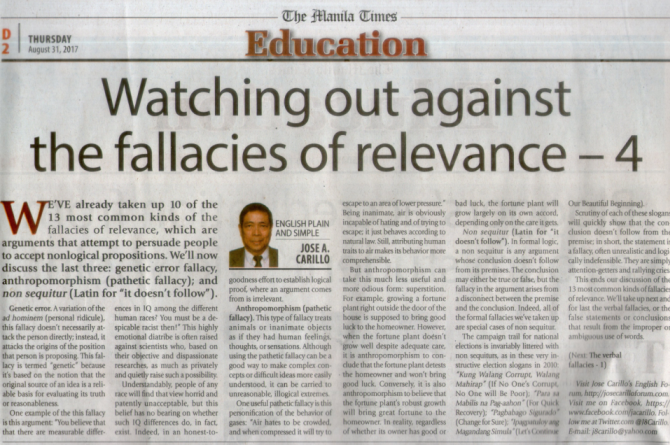We’ve already taken up 10 of the 13 most common kinds of
the fallacies of relevance, which are arguments that attempt to persuade people to accept nonlogical propositions. We’ll now discuss the last three: genetic error fallacy, anthropomorphism (pathetic fallacy); and
non sequitur (Latin for “it doesn’t follow”).
Genetic error. A variation of the
ad hominem (personal ridicule), this fallacy doesn’t necessarily attack the person directly; instead, it attacks the origins of the position that person is proposing. This fallacy is termed “genetic” because it’s based on the notion that the original source of an idea is a reliable basis for evaluating its truth or reasonableness.
One example of the this fallacy is this argument: “You believe that that there are measurable differences in IQ among the different human races? You must be a despicable racist then!” This highly emotional diatribe is often raised against scientists who, based on their objective and dispassionate researches, as much as privately and quietly raise such a possibility.
Understandably, people of any race will find that view horrid and patently unacceptable, but this belief has no bearing on whether such IQ differences do, in fact, exist. Indeed, in an honest-to-goodness effort to establish logical proof, where an argument comes from is irrelevant.
Anthropomorphism (pathetic fallacy). This type of fallacy treats animals or inanimate objects as if they had human feelings, thoughts, or sensations. Although using the pathetic fallacy can be a good way to make complex concepts or difficult ideas more easily understood, it can be carried to unreasonable, illogical extremes.
One useful pathetic fallacy is this personification of the behavior of gases: “Air hates to be crowded, and when compressed it will try to escape to an area of lower pressure.” Being inanimate, air is obviously incapable of hating and of trying to escape; it just behaves according to natural law. Still, attributing human traits to air makes its behavior more comprehensible.
But anthropomorphism can take this much less useful and more odious form: superstition. For example, growing a fortune plant right outside the door of the house is supposed to bring good luck to the homeowner. However, when the fortune plant doesn’t grow well despite adequate care, it is anthropomorphism to conclude that the fortune plant detests the homeowner and won’t bring good luck. Conversely, it is also anthropomorphism to believe that the fortune plant’s robust growth will bring great fortune to the homeowner. In reality, regardless of whether its owner has good or bad luck, the fortune plant will grow largely on its own accord, depending only on the care it gets.
Non sequitur (Latin for “it doesn’t follow”). In formal logic, a non sequitur is any argument whose conclusion doesn’t follow from its premises. The conclusion may either be true or false, but the fallacy in the argument arises from a disconnect between the premise and the conclusion. Indeed, all of the formal fallacies we’ve taken up are special cases of non sequitur.
The campaign trail for national elections is invariably littered with non sequiturs, as in these very instructive election slogans in 2010:
“Kung Walang Corrupt, Walang Mahirap” (If No One’s Corrupt, No One will Be Poor);
“Para sa Mabilis na Pag-aahon” (For Quick Recovery);
“Pagbabago Sigurado” (Change for Sure);
“Ipagpatuloy ang Magandang Simula” (Let’s Continue Our Beautiful Beginning).
Scrutiny of each of these slogans will quickly show that the conclusion doesn’t follow from the premise; in short, the statement is a fallacy, often unrealistic and logically indefensible. They are simply attention-getters and rallying cries.
This ends our discussion of the 13 most common kinds of fallacies of relevance. We’ll take up next and for last
the verbal fallacies, or the false statements or conclusions that result from the improper or ambiguous use of words.
(Next:
Watching out against the verbal fallacies – 1) September 7, 2017
 This essay appeared in the column “English Plain and Simple” by Jose A. Carillo in the Education Section of the August 31, 2017 issue (print edition only) of
This essay appeared in the column “English Plain and Simple” by Jose A. Carillo in the Education Section of the August 31, 2017 issue (print edition only) of The Manila Times
, © 2017 by the Manila Times Publishing Corp. All rights reserved.RETROSPECTIVE - THE FULL SERIES ON LOGICAL FALLACIES:July 20, 2017:
Watching out against the material fallacies – 1July 27, 2017:
Watching out against the material fallacies – 2August 10, 2017:
Watching out against the fallacies of relevance – 1August 17, 2017:
Watching out against the fallacies of relevance – 2August 24, 2017:
Watching out against the fallacies of relevance – 3August 31, 2017:
Watching out against the fallacies of relevance – 4September 7, 2017:
Watching out against the verbal fallacies – 1September 14, 2017:
Watching out against the verbal fallacies – 2